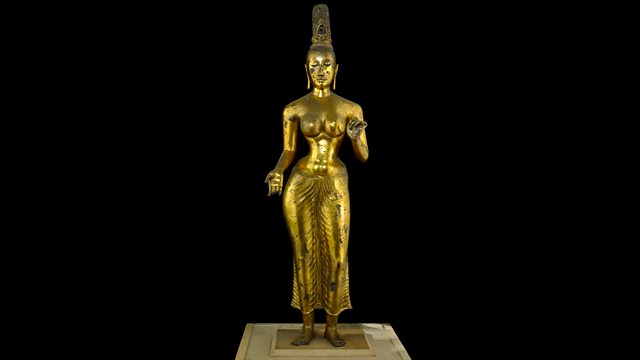Statue of Tara
Neil MacGregor's world history as told through individual objects at the British Museum. Today he arrives in Sri Lanka 1,200 years ago with a beguiling image of Tara
The history of the world as told through one hundred of the objects. The objects are selected from the collection of the British Museum by its director, Neil MacGregor.
This week, Neil is exploring life in the great royal courts across the world during Europe's medieval period. It's easy to forget that the civilisations of Tang China, the Islamic Empire and the Maya in Mesoamerica were all at their peak during this time and today we discover what was happening in South Asia during this period. He tells the story through a beautiful statue of the female Buddhist deity, Tara, crafted for a powerful ruler in Sri Lanka 1,200 years ago. Richard Gombrich explains what Tara means to Buddhism and the historian Nira Wickramasinghe describes the powerful interaction between Hinduism and Buddhism, India and Sri Lanka at this time.
Producer: Anthony Denselow
Last on
![]()
Discover more programmes from A History of the World in 100 Objects about religion
About this object
Location: Sri Lanka
Culture: Ancient South Asia
Period: AD 700-750
Material: Metal and Gold
Μύ
This statue of the Buddhist goddess Tara combines the spiritual and the sensual. The sculpture would have been used as a focus for meditation on the qualities Tara represents ? mercy and compassion. Originally the sculpture would have been placed in a temple alongside a statue of her male companion, the bodhisattva, Avalokiteshevara. Bodhisattvas are beings who have reached enlightenment but have turned back from it, out of compassion so that they can still help mankind escape from the cycle of death, rebirth and suffering.
Who commisioned this statue?
When this sculpture was made, Sri Lanka had been predominantly Buddhist for about 1,000 years. It was then a hub for Indian Ocean trade and the sculpture may have been made by one of the Sri Lankan kings. Tara appears as a goddess in both Hinduism and Buddhism, as both religions share a common Indian cultural background. The earliest Buddhist deities were conceived as male and Mahayana Buddhism may have incorporated female deities, like Tara, to attract more female worshipers.
Did you know?
- Tara is no longer worshipped in Sri Lanka, but is still one of the most popular female deities in Nepal and Tibet.
The epitome of beauty
By Sona Datta, curator, British Museum
Μύ
This image of the Buddhist goddess, Tara, is unusual for being standing and almost life-size. If you look at her for long enough she may reach out and touch you.
Tara is the consort of a Bodhisattva – a Buddhist deity who, having achieved enlightenment, chose to relinquish it to help alleviate the suffering of humanity. Tara’s right hand thus reaches forward in a gesture of giving. She is both regal and human. Her narrow waist, rounded hips, full breasts, lips and large almond-shaped eyes all represent the Indian epitome of feminine beauty.
Yet the magnificent image of Tara which stands proudly at the head of the main gallery for South Asia at the British Museum did not always enjoy such an impressive position. When first received into the Museum’s collection in 1830, she was kept from open display for fear her overtly erotic form may offend delicate contemporary sensibilities. However, in ninth century Sri Lanka, Tara’s curvaceous figure and full breasts would have had an entirely different association. Indeed, her very sensuality was precisely what would inspire awe and veneration.
Within Hinduism, Buddhism and Jainism, the division between the sacred and the profane was always a fluid one. Thus the divine, or aspects of it, could be found in all spheres of life. Indeed, there was no part of life in which the divine was not present.
Tara is a goddess of the Mahayana Buddhism. However, Theravada Buddhism is practised in Sri Lanka today, so this image of Tara offers incontrovertible evidence for the presence of Mahayana Buddhism in the island of Sri Lanka.
The unusual circumstances in which Tara was discovered suggest that she was also emblematic for reflecting a practice common in medieval India: the appropriation of images as loot. She was unearthed from a field where she was probably hidden (and forgotten) for the better part of 600 years. This could possibly have been to protect her from the arrival of Islam in Southern India and Sri Lanka in the thirteenth century, or even earlier to protect her from invaders from the Hindu Kingdoms of Southern India.
Human agency is always involved in the transportation of objects and in medieval India the plundering of objects for the validation of victory in war was one of the primary objectives of conflict. Indeed, it was a conspicuously moral action.
Transcript
Broadcasts
- Thu 17 Jun 2010 09:45Βι¶ΉΤΌΕΔ Radio 4 FM
- Thu 17 Jun 2010 19:45Βι¶ΉΤΌΕΔ Radio 4
- Fri 18 Jun 2010 00:30Βι¶ΉΤΌΕΔ Radio 4
- Thu 17 Jun 2021 13:45Βι¶ΉΤΌΕΔ Radio 4 FM
Featured in...
![]()
Religion—A History of the World in 100 Objects
A History of the World in 100 Objects - objects related to religion.
Podcast
-
![]()
A History of the World in 100 Objects
Director of the British Museum, Neil MacGregor, retells humanity's history through objects





